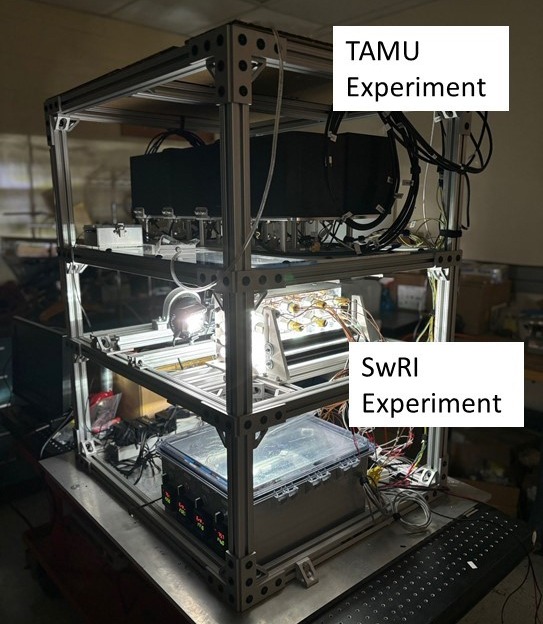Background
Missions returning to the Moon or to Mars, with their lower gravitational acceleration, require expanded knowledge of the effects of reduced gravity on fluid behaviors in these environments, particularly two-phase fluids in contact with solid surfaces. Decades of research in microgravity fluid physics have provided extensive data for model and technology validation for space flight systems, but there is little to no data available across a range of partial gravity levels for lunar or Martian terrestrial systems. For example, bubbles that remain in contact with surfaces can lead to reduced heat and mass transfer in heat exchangers, the coalescence of small bubbles into larger ones that can damage equipment, and the increased boiloff of cryogenic propellants in storage tanks. Research on partial gravity two-phase fluid physics applies to lunar and Martian surface power systems, life support systems design, cryogenic fuel management, and in situ resource utilization (ISRU).
Texas A&M University (TAMU) and SwRI (Divisions 18 and 15) are executing a joint research program to study how bubbles detach from surfaces in reduced gravity. TAMU is providing payload space to SwRI in exchange for SwRI supporting TAMU’s experiment that is focused on bubble detachment from typical surfaces. SwRI’s experiments will demonstrate whether engineered surfaces could improve bubble detachment in reduced gravity. The experiments were conducted aboard a reduced gravity aircraft in May 2023.
Approach
SwRI’s experiment has been designed to heat stainless steel surfaces and boil FC-72 (an inert heat transfer fluid) aboard Zero-G’s reduced gravity aircraft. The surfaces are approximately 0.5-inches square. In addition to bare stainless steel, three surface modifications will be explored including two with disordered etching and one with a hydrophobic coating. The experiment will be mounted in a payload rack with TAMU’s experiment as shown in Figure 1. During the flight, high-speed video cameras will capture bubble nucleation and detachment volume, and various temperature measurements will be used to calculate the surface heat flux.
Accomplishments
The experiment has been fabricated and ground-based checkout testing has been completed. The checkout testing finalized the imaging parameters (focal length, frame rate, lighting, etc.) needed to capture boiling data as shown in Figure 2. Ground-based testing has also defined variables that will be explored during the reduced gravity flight and the experiment operating procedures. The payload is undergoing final preparations to achieve flight-ready status including securing equipment and wiring to the payload rack. The flight experiment is scheduled to occur in late April 2024. Final data analysis is expected to be completed by Summer 2024.

Figure 1: SwRI has designed a flight-ready test rig to study nucleate boiling in reduced gravity aboard Zero-G Corporation’s parabolic aircraft. The test rig also includes an experiment operated by Texas A&M University as part of a joint research campaign to study bubble dynamics in reduced gravity that can eventually be applied to lunar and Martian in-situ resource utilization technology.

Figure 2: The experiment includes several stainless steel test articles with different surface treatments as shown in this ground-based nucleate boiling test. The researchers will quantify the heat transfer and bubble sizes for each surface in reduced gravity.
